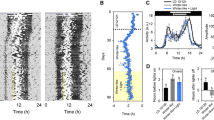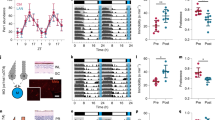Abstract
Clinical studies have clearly indicated that acute episodes and relapses of major depressive illness are characterized by a rhythmic cycle during the year, their incidence being highest during the spring and autumn.1 In addition, circadian modifications in the mood of depressed patients and in the efficacy of antidepressive therapies have been observed2–4 together with disruption or desynchronization of hormonal circadian patterns.5 Based on the above observations, it has been postulated that in those depressed patients susceptible to seasonal bouts of the illness, a circadian and/or seasonal desynchronization occurs and may be corrected by antidepressant drugs1,6 or light therapy.4
Access this chapter
Tax calculation will be finalised at checkout
Purchases are for personal use only
Preview
Unable to display preview. Download preview PDF.
Similar content being viewed by others
References
Wehr TA, Wirz-Justice A. Circadian rhythm mechanisms in affective illness and in antidepressant drug reaction. Pharmacopsychiatry 1982; 15: 31–39.
Goodwin FK, Wirz-Justice A, Wehr TA. Evidence that the pathology of depression and the mechanism of action of antidepressant drugs involve alterations in circadian rhythms. Adv Biochem Psychopharmacol 1982; 32: 1–11.
Herrmann L. Circadian rhythm, depression, antidepressants, single dose. Pharmacopsychiatry 1984; 17: 69–70.
Lewy AJ, Sack RL, Miller LS, et al. Antidepressant and circadian phase-shifting effects of light. Science 1987; 235: 352–354.
Leonard BE. Neurotransmitter receptors, endocrine responses and the biological substrates of depression: a review. Hum Psychopharmacol 1986; 1: 3–21.
Wirz-Justice A, Kafka MS, Naber D, et al. Circadian rhythms in rat brain alpha- and beta-adrenergic receptors are modified by chronic imipramine. Life Sci 1980, 27: 341–347.
Langer SZ, Zariflan E, Briley M, et al. High affinity binding of 3H-imipramine in brain and platelets and its relevance to the biochemistry of affective disorders. Life Sci 1981; 29: 211–220.
Langer SZ, Moret C, Raisman R, et al. High affinity 3H-imipramine binding in rat hypothalamus: association with uptake of serotonin but not of norepinephrine. Science 1980; 210: 1133–1135.
Mocchetti I, Brunello N, Racagni G. Ontogenetic study of 3H-imipramine binding sites and serotonin uptake system: indication of possible interdependence. Eur J Pharmacol 1982; 83: 151–152.
Brunello N, Riva M, Volterra A, et al. Age-related changes in 5-HT uptake and [3H]imipramine binding sites in rat cerebral cortex. Eur J Pharmacol 1985; 110: 393–394.
Langer SZ, Raisman R. Binding of 3H-imipramine and 3H-desipramine as biochemical tools for studies in depression. Neuropharmacology 1983; 22: 407–413.
Arora RC, Kregel L, Meltzer HY. Seasonal variation of serotonin uptake in normal controls and depressed patients. Biol Psychiatry 1984; 19: 795–804.
Whitaker PM, Warsh JJ, Stancer HC, et al. Seasonal variation in platelet 3H-imipramine binding: comparable values in control and depressed populations. Psychiatr Res 1984; 11: 127–131.
Egrise D, Rubistein M, Schoutens A. Seasonal variation of platelet serotonin uptake and 3H-imipramine binding in normal and depressed subjects. Biol Psychiatry 1986; 21: 283–292.
Baumann PA, Maitre L. Blockade of presynaptic alpha-receptors and of amine uptake in the rat brain by the antidepressant mianserin. Naunyn Schmiedebergs Arch Pharmacol 1977; 300: 31–37.
Campbell IC, Durcan MJ, Wirz-Justice A, et al. Circadian rhythms in brain adrenergic receptors and the influence of mood-modifying drugs. In Schou JS, Geisler A, Norn S (eds): Drug Receptors and Dynamic processes in Cells. Copenhagen: Munksgaard, 1986; 269–285.
Brunello N, Rovescalli AC, Riva M, et al. Lack of serotonergic modulation on 3H-imipramine binding sites in basal conditions and during prolonged treatment with desmethylimipramine. Psychopharmacol Bull 1986; 22: 931–936.
Brunello N, Riva M, Volterra A, et al. Effect of some tricyclic antidepressants on 3H-imipramine binding and serotonin uptake in rat cerebral cortex after prolonged treatment. Fundam Clin Pharmacol 1987; 1: 327–333.
Habert E, Graham D, Langer SZ. Solubilization and characterization of the 5-hydroxytryptamine transporter complex from rat cerebral cortical membranes. Eur J Pharmacol 1986; 122: 197–204.
Editor information
Editors and Affiliations
Rights and permissions
Copyright information
© 1989 Springer-Verlag New York Inc.
About this chapter
Cite this chapter
Racagni, G., Rovescalli, A.C., Galimberti, R., Riva, M., Brunello, N. (1989). Light-Dark-Related Changes in the Serotonin Uptake Molecular Complex in Rat Brain: Involvement in Antidepressant Action. In: Lerer, B., Gershon, S. (eds) New Directions in Affective Disorders. Springer, New York, NY. https://doi.org/10.1007/978-1-4612-3524-8_20
Download citation
DOI: https://doi.org/10.1007/978-1-4612-3524-8_20
Publisher Name: Springer, New York, NY
Print ISBN: 978-0-387-96769-1
Online ISBN: 978-1-4612-3524-8
eBook Packages: Springer Book Archive




